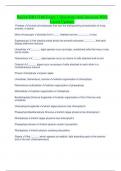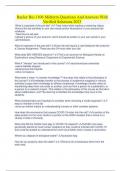Baylor bio 1106 - Study guides, Class notes & Summaries
Looking for the best study guides, study notes and summaries about Baylor bio 1106? On this page you'll find 22 study documents about Baylor bio 1106.
Page 2 out of 22 results
Sort by
Baylor BIO 1106 Exam 1 Questions And Answers With Latest Updates Baylor BIO 1106 Exam 1 Questions And Answers With Latest Updates
Baylor Bio 1106 Midterm Questions And Answers With Verified Solutions 2023 Baylor Bio 1106 Midterm Questions And Answers With Verified Solutions 2023
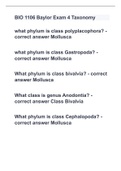
-
BIO 1106 Baylor Exam 4 Taxonomy 2023 with 100% complete solutions already graded A
- Exam (elaborations) • 7 pages • 2023
- Available in package deal
-
- $14.49
- + learn more
what phylum is class polyplacophora? Mollusca what phylum is class Gastropoda? Mollusca 00:23 01:22 What phylum is class bivalvia? Mollusca What class is genus Anodontia? Class Bivalvia What phylum is class Cephalopoda? Mollusca What class is genus Loligo? Class Cephalopoda What phylum is subphylum Chelicerata? Arthropoda What subphylum is class merostomata? Chelicerata What class is genus Limulus? merostomata What...

-
Baylor BIO 1106 Exam 1 Questions And Answers With Latest Updates
- Exam (elaborations) • 21 pages • 2023
-
- $14.49
- + learn more
Baylor BIO 1106 Exam 1 Questions And Answers With Latest Updates Protests include all eukaryotes that lack the distinguishing chracteristics of fungi, animals, or plants Moist microscopic protists live in ____ habitats and are ________ in size Supergroups we classify protist phyla into several eukaryotic ________ that each display distinctive features Unicellular _______ algal species occur as single, unattached cells that may or may not be motile Filamentous ______ algal species o...
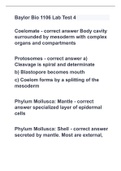
-
Baylor Bio 1106 Lab Test 4 2022/2023 with 100% complete solutions
- Exam (elaborations) • 34 pages • 2023
- Available in package deal
-
- $15.99
- + learn more
Coelomate Body cavity surrounded by mesoderm with complex organs and compartments Protosomes a) Cleavage is spiral and determinate b) Blastopore becomes mouth c) Coelom forms by a splitting of the mesoderm 00:21 01:22 Phylum Mollusca: Mantle specialized layer of epidermal cells Phylum Mollusca: Shell secreted by mantle. Most are external, some are remnants, some have no shells Describe the coelom for Phylum Mollusca The coelom is only a small chamber ...
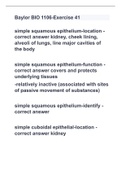
-
Baylor BIO 1106-Exercise 41 with 100% complete solutions
- Exam (elaborations) • 20 pages • 2023
- Available in package deal
-
- $16.49
- + learn more
simple squamous epithelium-location kidney, cheek lining, alveoli of lungs, line major cavities of the body simple squamous epithelium-function covers and protects underlying tissues -relatively inactive (associated with sites of passive movement of substances) 00:18 01:22 simple squamous epithelium-identify simple cuboidal epithelial-location kidney simple cuboidal epithelial-function covers and protects underlying tissues simple cuboidal epithe...
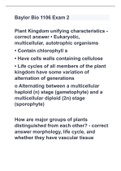
-
Baylor Bio 1106 Exam 2 2023 with 100% complete solutions already graded A
- Exam (elaborations) • 42 pages • 2023
- Available in package deal
-
- $15.99
- + learn more
Plant Kingdom unifying characteristics • Eukaryotic, multicellular, autotrophic organisms • Contain chlorophyll a • Have cells walls containing cellulose • Life cycles of all members of the plant kingdom have some variation of alternation of generations o Alternating between a multicellular haploid (n) stage (gametophyte) and a multicellular diploid (2n) stage (sporophyte) How are major groups of plants distinguished from each other? morphology, life cycle, and whether they ...

-
Baylor Bio 1106 Midterm 2021 with 100% complete solutions
- Exam (elaborations) • 9 pages • 2023
- Available in package deal
-
- $16.49
- + learn more
What is expected of the pre-lab? -Take notes while reading or watching videos. -Record the lab activities in your own words and/or illustrations in your physical lab notebook. -Take the pre-lab quiz. -Upload a picture of your protocol, which should be written in your own words in your Lab Notebook. What is expected of the post lab? Each lab will require a Lab Notebook-like entryinto a Canvas Assignment. These are due 24 hours after your lab. 00:02 01:22 What does BIO...
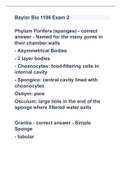
-
Baylor Bio 1106 Exam 2 with 100% complete solutions
- Exam (elaborations) • 4 pages • 2023
- Available in package deal
-
- $14.99
- + learn more
Phylum Porifera (sponges) - Named for the many pores in their chamber walls - Asymmetrical Bodies - 2 layer bodies - Choanocytes: food-filtering cells in internal cavity - Spongico: central cavity lined with choanocytes Ostiym: pore Osculum: large hole in the end of the sponge where filtered water exits Grantia - Simple Sponge - tubular - filter-feeding heterotrophs - Digestion is intracellular 00:03 01:22 Eplectella Ornate Lattice Structure Complicated white...
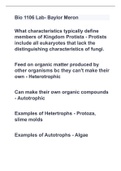
-
Bio 1106 Lab- Baylor Meron with 100% complete solutions already graded A
- Exam (elaborations) • 42 pages • 2023
- Available in package deal
-
- $15.99
- + learn more
What characteristics typically define members of Kingdom Protista Protists include all eukaryotes that lack the distinguishing characteristics of fungi. Feed on organic matter produced by other organisms bc they can't make their own Heterotrophic 00:22 01:22 Can make their own organic compounds Autotrophic Examples of Hetertrophs Protoza, slime molds Examples of Autotrophs Algae Three types of cellular organization in algae unicellular, filamen...

Study stress? For sellers on Stuvia, these are actually golden times. KA-CHING! Earn from your study resources too and start uploading now. Discover all about earning on Stuvia

